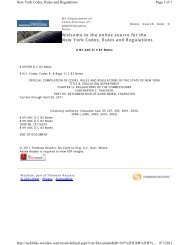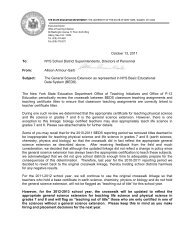ESL Learning Standards - Higher Ed - New York State Education ...
ESL Learning Standards - Higher Ed - New York State Education ...
ESL Learning Standards - Higher Ed - New York State Education ...
You also want an ePaper? Increase the reach of your titles
YUMPU automatically turns print PDFs into web optimized ePapers that Google loves.
<strong>Standards</strong>-based <strong>ESL</strong><br />
instruction interweaves all<br />
four language skill areas:<br />
reading, writing, speaking,<br />
and listening.<br />
Developing cultural awareness<br />
is interwoven throughout<br />
all of the standards.<br />
meet Standard 3, LEP/ELLs are expected to take an experience, text, or idea, and<br />
question it from a variety of critical perspectives. These viewpoints are informed<br />
by the students’ cultural background and their experiences as newcomers to the<br />
United <strong>State</strong>s.<br />
Standard 4: English for social and classroom interaction outlines the skills<br />
and strategies, both in and out of school, that LEP/ELLs must master to communicate<br />
effectively in English. The focus of Standard 4 is to develop the competencies<br />
students need to engage in functions such as negotiating, explaining, participating<br />
in discussions, following and providing directions, and requesting and<br />
providing assistance in English. The indicators in Standard 4 apply to an array of<br />
meaningful and authentic communicative contexts, from informal social situations<br />
to formal academic situations.<br />
Standard 5: English for cross-cultural knowledge and understanding articulates<br />
the components of acquiring a "second culture" in both a social and academic<br />
context. Interactions and knowledge that are subsumed under Standard 5<br />
are designed to help LEP/ELLs entering the United <strong>State</strong>s to be successful in their<br />
new host culture. Standard 5 validates and builds on the cultural background of<br />
the individual student, promotes articulation and exchanges of ideas and assumptions<br />
across cultures, and provides a context in which the student can explicitly<br />
and implicitly acquire knowledge and understandings that facilitate the process of<br />
acculturation.<br />
Teaching to Standard 5 requires an awareness of the dimensions of culture by <strong>ESL</strong><br />
teachers, bilingual teachers, and other educators of LEP/ELLs. These dimensions<br />
include the varieties of cultural practices, norms, beliefs, assumptions, and expectations<br />
that fall under the general descriptor of "American." In addition, attention to<br />
Standard 5 heightens the contribution cultural diversity makes to classroom instruction<br />
and interaction. <strong>Ed</strong>ucation under Standard 5 does not promote a list of cultural<br />
"facts" or "do’s and don’ts," but, rather, encourages an exploration of the facets<br />
of culture, the student’s own as well as the cultures of others, and how culture is<br />
manifested in words, actions, and learning.<br />
PERFORMANCE INDICATORS<br />
While the sample tasks<br />
focus on performance indicators<br />
particular to one<br />
standard, they address indicators<br />
in other standards as<br />
well.<br />
The performance indicators of each standard identify the knowledge, skills, and<br />
abilities that students must master in order to demonstrate achievement of the standard.<br />
They inform instruction and assessment and move them toward task-oriented<br />
practices that address each standard. Content and concepts (e.g., "issues, ideas,<br />
texts, and experiences") that lead toward meeting the standard are specified in the<br />
performance indicators. In addition, the particular skills that students need to<br />
demonstrate (e.g., interpreting, analyzing, and evaluating) are outlined.<br />
Many performance indicators for each standard build cognitively from the early<br />
childhood level to the commencement level. These performance indicators are<br />
cumulative; they do not assume mastery of a particular indicator at prior grade levels.<br />
Some LEP/ELLs may demonstrate mastery of the performance indicators in their<br />
native language and thus require instruction in transferring these skills to English.<br />
Other students may not have these skills in their native language. For example, a<br />
high school <strong>ESL</strong> student cannot be assumed to have mastered the standard for the<br />
elementary or intermediate level, since this student might be a newly arrived student<br />
in his/her first or second year in the United <strong>State</strong>s. The performance indicators<br />
are thus written in a way that responds to the varied educational backgrounds<br />
of the <strong>ESL</strong> population.<br />
8 <strong>Learning</strong> <strong>Standards</strong> for <strong>ESL</strong>
















